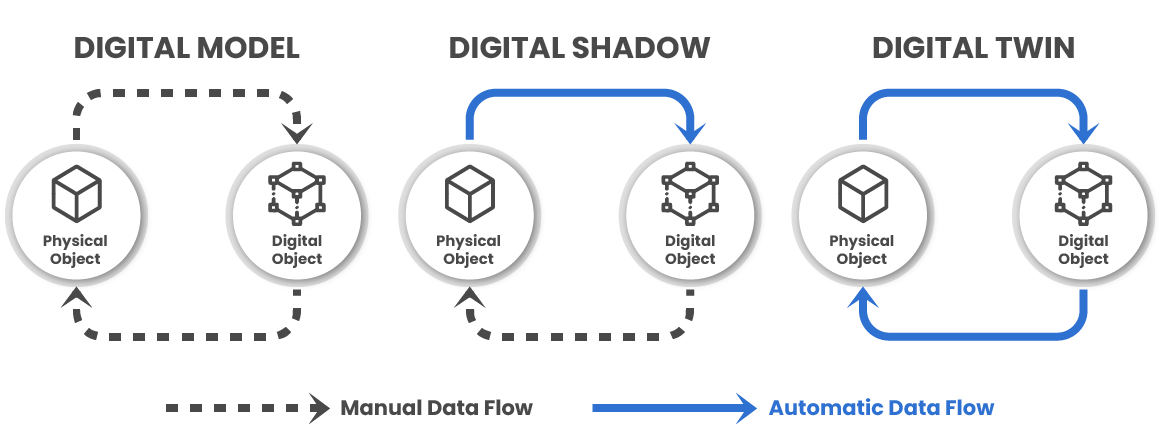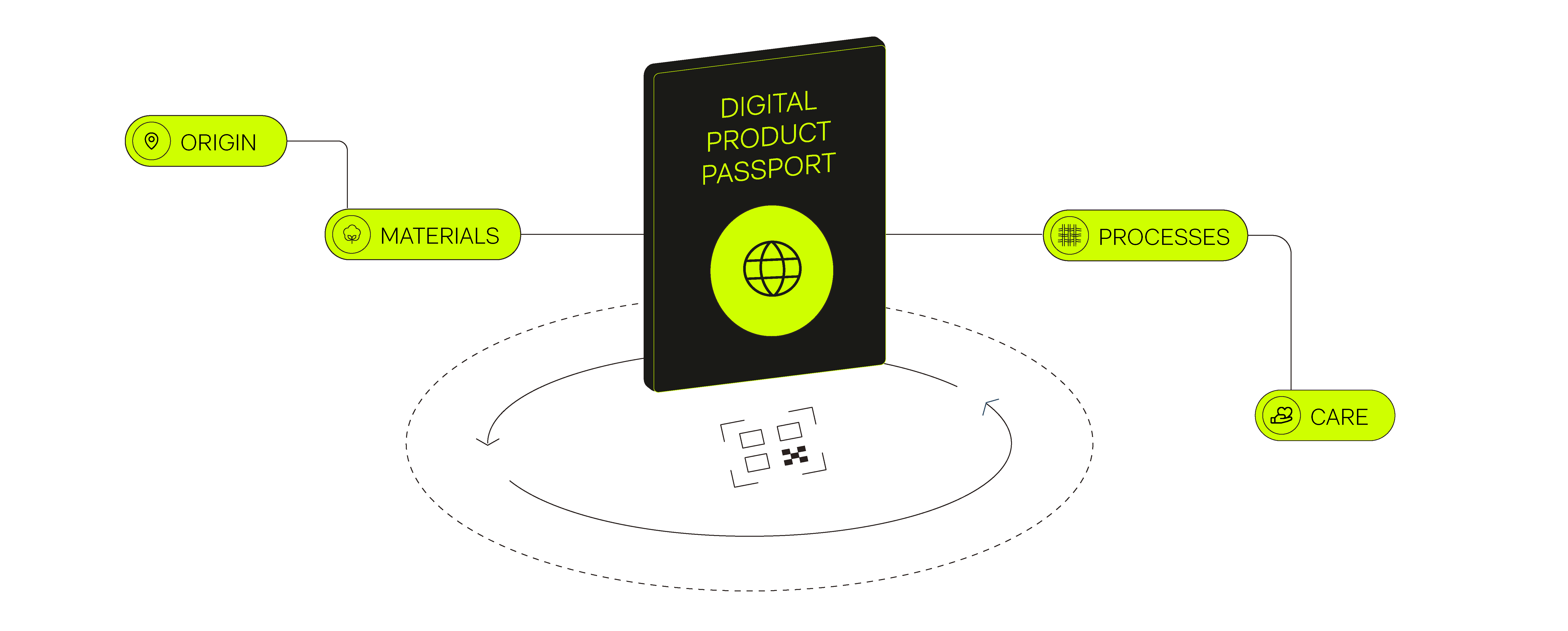Digital Twins, are digital replicas of physical assets, processes, or systems used to simulate, monitor, and optimize their real-world counterparts. Through real-time data exchange and advanced analytics, digital twins provide a virtual environment for testing scenarios, predicting outcomes, and enhancing decision-making. This concept, first introduced by Michael Grieves in 2002, has rapidly evolved and now plays a crucial role in various sectors, including manufacturing, healthcare, smart cities, supply chains, and more.
They serve as the foundation for emerging tools like the Digital Product Passport, which aims to enhance transparency, traceability, and circularity in product lifecycles.
Digital Twins are the entry point and keystone transitioning to Industry 4.0. In the context of Industry 5.0, they align with goals such as human-centric innovation, sustainability, and resilience.
Motivations for Digital Twins: Why They Matter
- Enhanced Decision-Making and Planning
-
Digital twins, provide a comprehensive view of an asset’s entire lifecycle, from design to decommissioning. This capability enables organizations to leverage real-time data and predictive insights for more informed decision-making, reducing risk and optimizing costs.
- Operational Efficiency and Optimization
-
By continuously monitoring the performance of physical assets, digital twins help identify inefficiencies, predict maintenance needs, and minimize downtime. This leads to higher operational efficiency and lower total cost of ownership.
- Innovation and Experimentation
-
Digital twins offer a safe, virtual environment to test new designs, configurations, or operational strategies without the risks or costs associated with real-world experimentation.
- Sustainability and Circular Economy
-
Digital twins are critical for achieving sustainability goals by optimizing resource utilization, reducing waste, and supporting lifecycle management. They align with the principles of the circular economy.
- Enabling Digital Product Passports
-
Digital twins provide the real-time data needed for DDPs, which are digital records of a product’s lifecycle.
The Evolution of Digital Twins: From Concept to Industry 5.0
Digital twins have evolved, from simple static models to dynamic, interconnected digital ecosystems aligned with Industry 5.0’s goals.
- Digital Model
-
A digital model is a static, digital representation of a physical entity, such as a 3D CAD model or a blueprint, without real-time data updates or interactions with the physical world.
- Digital Shadow
-
A digital shadow reflects the state of a physical entity with data flowing in one direction—from the physical asset to the digital model. It monitors changes but can’t influence the physical counterpart.
- Digital Twin
-
A digital twin involves a two-way, real-time data exchange between a physical entity and its digital replica. This interactivity allows for dynamic optimization, predictive maintenance, and enhanced decision-making by creating a continuous feedback loop.
- Digital Twin Aggregate
-
This concept refers to multiple interconnected digital twins, that collectively represent a complex system, such as a factory, a city, or a global supply chain. Digital Twin Aggregates provide a holistic view and facilitate coordinated management and optimization across different entities.
- Industry 5.0 and Human-Centric Digital Twins
-
In the era of Industry 5.0, digital twins are evolving to be more human-centric, focusing on enhancing human-machine collaboration, resilience, and sustainability. Industry 5.0 emphasizes using digital twins to improve human well-being, creativity, and decision-making while ensuring that technological progress is sustainable and inclusive.
Classification of Digital Twins
Digital twins can be categorized by their scope and application:
- Product Digital Twins
-
These twins represent individual products or components, such as a vehicle engine or a part of manufacturing equipment.
- Process Digital Twins
-
These represent entire processes or workflows, such as production lines or supply chains and so are used for optimization, efficiency, predictions, and performance enhancement.
- System Digital Twins
-
System twins encompass multiple interconnected assets or subsystems, such as a power grid or a transportation network.
- Environment Digital Twins
-
These twins represent large-scale environments, such as smart cities, buildings, or natural ecosystems. They are used to also to analyze and optimize urban planning, resource management, and environmental impact.

Digital Product Passport and Integration with Digital Twins
DPPs are digital documents that maintain up-to-date information on a product’s lifecycle, including origin, materials, manufacturing processes, and end-of-life management. Digital twins, by mirroring the physical product and capturing real-time lifecycle data, ensure that DDP remain accurate and up-to-date across the product’s lifecycle.
Motivations for DDPs include:
- Transparency and Compliance
-
DPPs provide an exhaustive record of a product’s entire lifecycle, supporting regulatory compliance and ethical practices.
- Consumer Awareness
-
DPPs enable consumers to make informed decisions by offering detailed information on a product’s sustainability credentials and sourcing.
- Facilitating Circular Economy
-
By providing critical information on product composition, condition, and recycling options, DPPs support reuse, refurbishment, and recycling.

Meta-Model Frameworks for Digital Twins
To handle the complexity and diverse applications of digital twins, to describe all the affordances (capability of a device, in the IoT world) of the physical element, is needed a standardized meta-model framework. There is no single standard but more frameworks exist and are integrated across different digital twin systems.
- Web of Things
-
The WoT is an architecture developed by the World Wide Web Consortium (W3C) that enables interoperability between IoT devices and digital twins. WoT provides a standardized way to describe devices, their capabilities, and their interactions, ensuring that data from different devices can be seamlessly integrated.
- One Data Model
-
OneDM is a collaborative initiative developed to create a unified data model for IoT devices. By defining a common semantic vocabulary and data structure, OneDM facilitates interoperability between devices from different manufacturers.
- Digital Twin Definition Language
-
DTDL is a language developed by Microsoft to define digital twins’ structure, behavior, and relationships. It provides a standardized way to describe: the properties, telemetry, commands, and components of a digital twin, making it easier to create, manage, and interact with digital twins.
Architectural Approach for IoT Digital Twins: Domain-Driven Design and Microservices
Adopting a robust architecture that supports scalability, flexibility, and resilience is essential to implement digital twins effectively within IoT environments. Two possible approaches, Domain-Driven Design and Microservices, can be particularly effective.
- Domain-Driven Design:
- Benefits for Digital Twins
-
DDD ensures that digital twin models are context-aware, aligned with business goals, and adaptable to changing requirements.
- Application in IoT Digital Twins
-
Bounded Contexts definition in DDD helps decompose the digital twin system into manageable modules that reflect real-world assets and their interactions.
- Microservices:
- Benefits for Digital Twins
-
Microservices enhance flexibility, scalability, and fault tolerance by allowing different components of the digital twin system to evolve and scale independently.
- Application in IoT Digital Twins
-
In digital twin implementations, microservices manage data acquisition, processing, analytics, user interfaces, and control functions independently, targeting fast flow and scaling.
Conclusion: The Future of Digital Twins
Digital twins will disrupt how we manage physical assets and processes in the era of Industry 5.0. but also in the Consumer’s day-by-day life. They enhance operational efficiency and innovation but can drive sustainability and human-centric outcomes.
Organizations integrating Physical Assets with Digital Twins, Digital Product Passports, and exportable models (Meta Model Frameworks) can position themselves as leaders in a more holistic Market. The strategy completes itself by adopting effective software architecture, considering Data Pipelines and AI integrations in the vision of communicating platforms. Logically, more challenges are ahead making the Digitals Twins a complicated task to follow: Cybersecurity, Interoperability, Obsolescence management, technology evolution, and so on.
The hope is to thrive in a future where transparency, collaboration, and adaptability are key, continuing to shape a more inclusive, efficient, and sustainable reality!